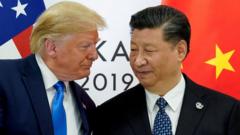Japanese defense officials have expressed grave concerns following a close encounter involving a Chinese fighter jet and a Japanese military aircraft, escalating tensions in an already complex regional security landscape.
Growing Tensions: Close Call Between Japanese and Chinese Military Aircraft

Growing Tensions: Close Call Between Japanese and Chinese Military Aircraft
Japan raises alarms over a Chinese fighter jet's dangerous proximity to a Japanese surveillance plane in the Pacific.
In a statement released on Thursday, Japan's Defense Ministry detailed an alarming incident that occurred over international waters in the Pacific last weekend. A Chinese J-15 fighter jet reportedly flew dangerously close to a Japanese P-3C patrol aircraft, which was on a surveillance mission. The Chinese aircraft approached as close as 150 feet from the Japanese plane on Saturday, and on Sunday, it aligned itself just 3,000 feet directly in front of the P-3C, raising fears of a catastrophic collision.
This incident occurred in the backdrop of a larger show of military prowess, as China had deployed two aircraft carriers, including the Shandong, into the Pacific Ocean for joint exercises, marking a significant expansion of its military operations beyond its coastline.
Japan's Defense Minister, Gen Nakatani, voiced serious concerns over the incident and emphasized the potential hazards if such dangerous maneuvers continue. “These actions could potentially lead to accidental collisions,” he noted during a security committee session in the Diet, Japan’s Parliament.
In further statements to the press, Gen. Yoshihide Yoshida, head of Japan’s joint staff, admitted he was troubled by the possibility of interaction between the Chinese jet—identified as possibly armed with missiles—and the Japanese patrol aircraft. He expressed uncertainty regarding the motivations behind the Chinese fighter's maneuvers but cautioned against the escalating pattern of China's military activities in the region, which he labeled as "intermittently and continuously unusual."
In response, Lin Jian, a spokesman for China's Foreign Ministry, claimed that Japan's military planes were the instigators of the incident as he defended China's operational conduct. He suggested that Japan should adopt a more rational perspective regarding these aerial activities.
The interaction between military aircraft is not isolated; a previous incident in 2022 involved a Chinese fighter jet coming within a mere 20 feet of an American military aircraft over the South China Sea, almost resulting in a collision. Historical context further complicates these aerial encounters, calling back to a fatal crash in 2001 when a U.S. Navy surveillance plane collided with a Chinese fighter, leading to the death of the Chinese pilot and an emergency landing by American crews in China.
Meaghan Tobin contributed reporting from Taipei, while Hisako Ueno and John Yoon are contributors based in Tokyo and Seoul, respectively, both focusing on the broader implications of military tensions and security dynamics in Northeast Asia.






















